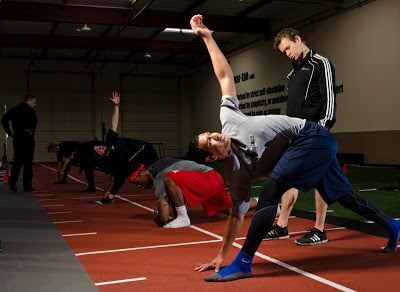
This was never an issue with our paleo ancestors because you “played” every day; your “game” was survival. The stakes and situation of today are not much different though; high school athletes play year round, and professionals fly across the country for back to back games. So if we all have to recover as fully as possible, do we
A. Find the best supplement to drink?
B. Hop in an ice bath?
C. Get a light workout?
D. Focus on some massage or myofascial release?
E. All of the above
Usually you cannot go wrong with (E) all of the above, but your life, and your athletic career, is all about prioritization.
First goal is to replace fluids (water) and provide protein to prevent muscle breakdown and encourage muscle damage recovery/building. Do not move on without this.
The only other PROVEN physical benefit is massage or myofascial release. This pressure can relieve muscle tension and trigger points to avoid excessive pressure on joints, cartilage, and musculotendinous junctions where strains occur. Do not move on without this.
Option C, ice baths, was a trick. No recent studies have shown any benefit, though this intervention has received some traction because we attribute the pain of ice cold water with improvement. In fact, this cold stimulus is suggested to DELAY healing by causing the vasoconstriction, narrowing of blood vessels, to prevent the delivery of healing. Contrast baths likewise, have no beneficial effects, though have shown no negative effects either. Hopefully, I do not need to make the evolutionary point on the availability of ice to the survival of our species. Please move on without this.
The last steps are more psychological recovery, to make you feel better. The general measurement is the Profile of Mood States (POMS) scores, which evaluates a host of factors including tension, anxiety, fatigue, and vigor. A study out of the School of Medicine in Hirosaki, Japan examined college athletes that incorporated low intensity exercise, actually lowered these POMS score, meaning the mood was higher in those players that performed this light movement afterwards.
Light exercise does not mean jogging or “flush runs” unless you enjoy feeling and playing worse. Our favorite in-season exercise is overhead squat. There is no eccentric stress to cause soreness, weight can be added each week so the athlete stays motivated, and the key benefit is mobility which is often lost from the volumes of sport.
Sleep has also shown large benefits to POMS, mostly through the vigor score, the single category that has consistently been shown to be most elevated in athletes versus non-athletes.
So if your test above was fill-in rather than multiple choice, here is your answer
After you eat, release, and get a light workout, go to bed (preferably not in an ice bath).